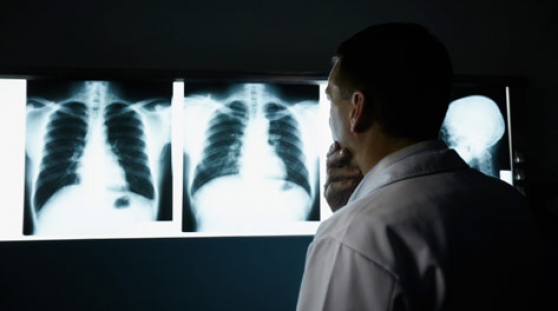Mesothelioma Health Center
Table of Contents

Because mesothelioma's symptoms and external signs can be attributed to other conditions, a medical diagnosis is necessary for cancer treatment.
A physical exam and examination of medical history is the initial way to determine if the body is unhealthy. A superficial check for lumps and abnormalities may be able to indicate the need for further extensive testing. A history of the patient's health habits, exposure to asbestos, past illnesses and treatments will also be taken.
A chest x-ray of the organs and bones inside the chest is another way to determine if an individual has mesothelioma. A complete blood count or CBC is a procedure in which a sample of blood is drawn and checked for the number of red blood cells, white blood cells and platelets, the amount of hemoglobin (a protein which carries oxygen) in the red blood cells and the portion of the blood sample made up of red blood cells. Additionally, a sedimentation rate can be used. A sedimentation rate is a procedure where the blood sample is tested for the rate at which the red blood cells settle to the bottom of the test tube.
A biopsy can detect abnormalities or defects in the patient's tissue. A biopsy for the testing of mesothelioma is the removal of cells or tissue from the pleura or peritoneum so they can be viewed underneath a microscope by a pathologist to check for signs of cancer. Procedures to collect cells or tissues include:
- Fine-needle (FNA): aspiration biopsy of the lung. This procedure removes tissue or fluid using a thin needle. An imaging procedure is then used to locate the abnormal tissue or fluid within the lung. A small incision may be made in the skin where the biopsy needle is inserted into the abnormal tissue or fluid, and a sample is removed.
- Thoracoscopy: An incision or cut is made between two ribs and a thoracoscope, a thin and tube-like instrument with a light and lens for viewing, is inserted into the chest.
- Peritoneoscopy: An incision is made in the abdominal wall and a peritoneoscope, a thin tube-like instrument with a light and lens for viewing, is inserted into the abdomen.
- Laparotomy: An incision is made in the wall of the abdomen to check the inside of abdomen for obvious signs of diseases.
- Thoracotomy: An incision is made between two ribs to check inside the chest for signs of disease.
A bronchoscopy is another procedure which is useful for determining the presence of mesothelioma. It is a procedure used to look inside the trachea and large airways in the lung for abnormal areas. A bronchoscope is a thin tube-like instrument with a light and lens for viewing and is inserted through the nose or mouth into the trachea and lungs. The instrument may have a tool to remove tissue samples in order to view them beneath a microscope.
A cytologic exam is the examination of cells under a microscope by a pathologist to check for any abnormalities. For mesothelioma, fluid is taken from where it has built up around the lungs or from the abdomen. A pathologist will then check the cells in the fluid.
A CT or MRI scan may be used once mesothelioma itself is diagnosed. Your doctor will want to see if the cancer has spread to other regions of the body.
